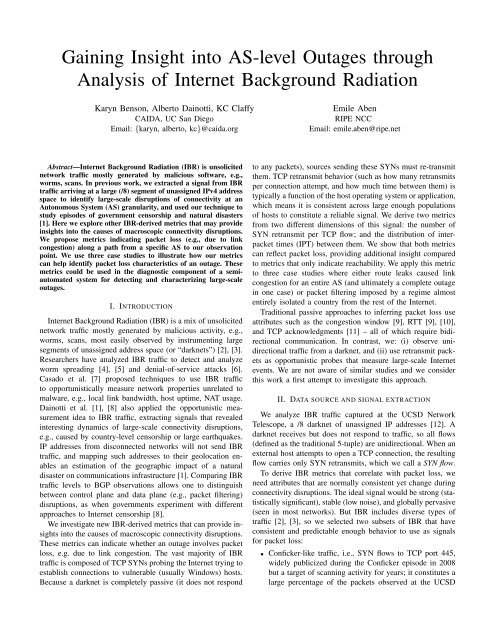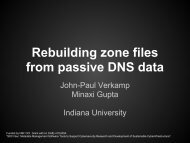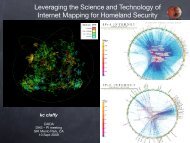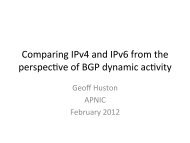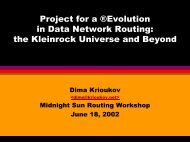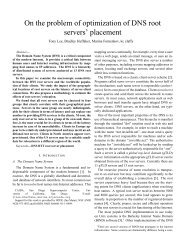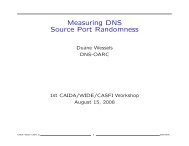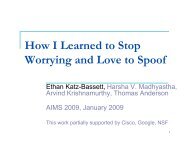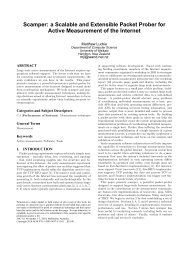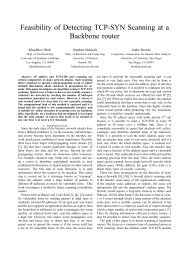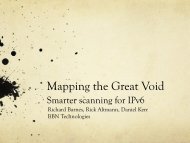Gaining Insight into AS-level Outages through Analysis of ... - Caida
Gaining Insight into AS-level Outages through Analysis of ... - Caida
Gaining Insight into AS-level Outages through Analysis of ... - Caida
Create successful ePaper yourself
Turn your PDF publications into a flip-book with our unique Google optimized e-Paper software.
4single packet is lost, the first IPT is either (approximately) 6,9, or 3 seconds corresponding to loss <strong>of</strong> the first, second, orthird packet, respectively. We can only calculate η on expected3-pkt SYN flows.As in the calculation <strong>of</strong> γ, we consider the possibility <strong>of</strong>skew from a few deviant hosts. If F s denotes the set <strong>of</strong> flowswith source IP s that are expected to have 3 packets and haveat least 2 packets, S = {s ∈ seen source IPs|F s ≠ ∅}, andthe function IPT(f) returns the first IPT <strong>of</strong> a flow f, then ourmetric isη = 1∑∑f∈F sIPT(f)(2)|S| |F s |s∈SIf |S| = 0, then η is undefined.η is a less precise metric than γ, since it uses fewerflows during connectivity disruptions, allowing it to skewmore easily. However, the combination <strong>of</strong> η and γ allows forstrong inference. A decrease in γ may also mean that fewerpackets than expected are actually being sent for a trafficclass instead <strong>of</strong> being lost along the path, but η can helpus distinguish between the two cases (i.e., assuming RFCcompliantbehavior, η can distinguish between sending onlytwo packets and a random loss <strong>of</strong> one <strong>of</strong> three packets).Figure 2 shows η calculated across all <strong>AS</strong>es for January 2012.IV. C<strong>AS</strong>E STUDIESIn this section, we evaluate our metric using three differentservice-disruption case studies. The first two outages – the“Dodo-Telstra” and the “Bell-Dery” case – had networkinducedpacket loss as a result <strong>of</strong> BGP route leaks [20], [21].The third one – the Libyan Internet blackout – was the result<strong>of</strong> packet filtering. If effective, our metrics will reflect packetloss in the first two case studies but not in the last.For each <strong>of</strong> the case studies, we only use metrics whichwere stable <strong>through</strong>out the entire month preceding the outage.A. “Dodo-Telstra” Routing LeakageOn February 23, 2012, around 2:40 UTC, the multi-homednetwork operator Dodo announced internal BGP routes to itsprovider Telstra, a major ISP in Australia, which erroneouslyaccepted them. As a result, Telstra sent all <strong>of</strong> its traffic tothe small network, Dodo, instead <strong>of</strong> a large transit provider,inducing a bottleneck leading to a complete outage [20]. Theeffect was massive: most Australians were left without Internetconnectivity for about half an hour [22].Figure 4 plots our metrics for IBR traffic originating from<strong>AS</strong>1221 (Telstra) calculated in 5-minute bins. The figureshows significant drops <strong>of</strong> both γ C and γ 3 during the firstphase (20 minutes) <strong>of</strong> the episode, meaning that far fewerpackets per flow were reaching the darknet than normal.However, when γ C and γ 3 first drop, η increases from about3 to 5 seconds, which corroborates packet loss (assumingindividual hosts did not change their retransmission patterns).This spike was calculated using the 7 distinct source IPsobserved from this region at the darknet. In the following three5-minute time bins the number <strong>of</strong> sources (0, 1, 2 respectively)contributing to the calculation <strong>of</strong> η was not statistically significant.Such a significant drop in γ C and γ 3 and the increasein η are a direct consequence <strong>of</strong> congestion on the affectedlinks. Routers started dropping packets, including some <strong>of</strong>the SYN packets destined to the darknet. Eventually, thiscongestion deteriorated to a complete outage (lasting another20 minutes), during which the telescope did not observe anysources sending SYN packets from Telstra (so our metricscannot be calculated).γ , η6543210002-23 01:30 02-23 03:00 02-23 04:30Conficker Sources3-SYN SourcesηFig. 4: Our packet-loss metrics plotted in 5-min. bins for trafficoriginating from <strong>AS</strong>1221 during the Dodo-Telstra routing leak inFebruary 2012. The arrow points at the first phase (20 minutes) <strong>of</strong> theoutage, where the metric values indicate a bottleneck, i.e., packet loss:γ C and γ 3 decreased, and η increased. The number <strong>of</strong> IPs sendingConficker traffic remained the same, while the number <strong>of</strong> IPs sending3-SYN flows decreased – an artifact <strong>of</strong> the frequency at which eachtype <strong>of</strong> host contacts the darknet. In the second phase, no flows wereobserved in the darknet traffic, implying a complete outage.B. “Bell-Dery” Routing LeakageOn August 8, 2012, at 17:27 UTC, dual-homed providerDery Telecom started to leak a full BGP table to the majorCanadian ISP Bell. These routes were accepted and propagatedto Bell’s peers [21]. Our analysis shows that the biggestdisruption lasted about half an hour.Figure 5 plots our metrics calculated for traffic comingfrom <strong>AS</strong>577 (Bell) surrounding the outage. The Bell networknever was completely <strong>of</strong>fline, but the plot indicates a severedisruption (∼17:30-17:45) followed by slight improvement(∼17:45-17:55) before restoration. During this time period,the total number <strong>of</strong> Conficker and 3-SYN source IPs droppedfrom about 12 and 20 to 2 and 6, respectively. Both γ 3and η indicate significant packet loss during this time period.Strangely, γ C stayed close to 2 during the worst part <strong>of</strong> thedisruption, decreasing slightly when conditions appeared toimprove (number <strong>of</strong> Conficker sources rose from 2 to 11).To determine the reason behind the differences in γ C andthe other two metrics, we broke down the traffic from <strong>AS</strong>577by network prefix and inspected the TTL header fields in thecollected packets. In the 90 minutes surrounding the outage,packets from <strong>AS</strong>577 originated from 63 distinct /16 prefixes,<strong>of</strong> which 38 sent traffic in at least 9 <strong>of</strong> 18 5-minute time bins,and all but one experienced a considerable volume drop. Uponfurther inspection, two IP addresses in this prefix continued toγ Cγ321181512963Source IPs
6metrics extracted from the Conficker signal implied networkinducedpacket loss (e.g congestion). However, γ C initiallypainted a different picture <strong>of</strong> packet loss: sources able to sendConficker-like traffic were unaffected. A deeper exploration<strong>of</strong> traffic volume by prefix and TTLs revealed that the connectivitydisruption was more severe for some subnets thanothers. This result demonstrated that multiple data classes andmetrics can strengthen the quality <strong>of</strong> inferences and provide astarting point for further investigation. In the Libyan InternetBlackout example, although the traffic volume was smaller,γ C remained at pre-censorship <strong>level</strong>s whenever Conficker-liketraffic was observed. This behavior is consistent with filteringpackets by subnet: the number <strong>of</strong> traffic sources decreases butper-flow characteristics will not change.V. CONCLUSIONTo augment the binary signal <strong>of</strong> presence or absence <strong>of</strong>traffic flows from a particular network, we explored IBRderivedmetrics that help characterize connectivity disruptionsthat induce packet loss, e.g., link congestion. Our metrics arebased on SYN retransmits in unsolicited Internet backgroundradiation, visible from passive darknet instrumentation. Becausethese retransmits typically follow consistent patterns thatare a function <strong>of</strong> operating system or application implementation,we can infer packet loss if some retransmits are notobserved by the darknet.We used three case studies to demonstrate that our γand η metrics can distinguish a transit bottleneck-inducedoutage from an intentional nation-wide disconnection causedby packet filtering. One unexpected finding was that in theBell-Dery route leak incident, different parts <strong>of</strong> the affected <strong>AS</strong>reacted differently to the route leak, confirmed by examination<strong>of</strong> TTL values on a per-prefix <strong>level</strong>. This analysis providedhints on how to group parts <strong>of</strong> a specific <strong>AS</strong> <strong>into</strong> finer-grainedunits that may be affected differently by a disruption.Our method has several limitations: it only measures packetloss between a given source and our darknet. It also relieson the presence <strong>of</strong> Conficker-like or IBR TCP traffic ingeneral. But our simple metrics applied to a large darknettraffic segment enable us to continually monitor one aspect <strong>of</strong>network connectivity (i.e., reachability to our darknet) fromall over the world.Our method is complementary to techniques using activeprobes to discover outages. Due to the large number <strong>of</strong>prospective IP addresses to probe, current active techniquesdo not ensure that the outage will be captured. For example,[23] only monitors /24s with a large number <strong>of</strong> responsiveIPs - which is about 9% <strong>of</strong> the allocated address space.Alternatively, [24] covers 89% <strong>of</strong> the Internet’s edge addressspace but the focus is on failures lasting longer than 15minutes.In the future we would like to test this metric on otherconnectivity scenarios and other darknet traffic, explore otherIBR-related metrics that can characterize network disruptions,and integrate such metrics <strong>into</strong> a system for comprehensivedetection and diagnosis <strong>of</strong> such disruptions.VI. ACKNOWLEDGEMENTSThis material is based upon work supported by the NationalScience Foundation under grants CNS-1059439 and CNS-1228994. Support for the UCSD network telescope operationsand data collection, curation, analysis, and sharing is providedby DHS cooperative agreement FA8750-12-2-0326, NSF grantCNS-1059439, and UCSD.REFERENCES[1] A. Dainotti, R. Amman, E. Aben, and K. C. Claffy, “Extracting Benefitfrom Harm: Using Malware Pollution to Analyze the Impact <strong>of</strong> Politicaland Geophysical Events on the Internet,” SIGCOMM Comput. Commun.Rev., 2012.[2] R. Pang, V. Yegneswaran, P. Barford, V. Paxson, and L. Peterson, “Characteristics<strong>of</strong> Internet Background Radiation,” in Internet MeasurementConference (IMC 2004), 2004.[3] E. Wustrow, M. Karir, M. Bailey, F. Jahanian, and G. Huston, “InternetBackground Radiation Revisited,” in Internet Measurement Conference(IMC 2010), 2010.[4] D. Moore, C. Shannon, and J. Brown, “Code-Red: a case study onthe spread and victims <strong>of</strong> an Internet worm,” in Internet MeasurementWorkshop (IMW 2002), 2002.[5] C. Shannon and D. Moore, “The Spread <strong>of</strong> the Witty Worm,” IEEESecurity and Privacy, 2004.[6] D. Moore, C. Shannon, D. J. Brown, G. M. Voelker, and S. Savage,“Inferring Internet Denial-<strong>of</strong>-Service Activity,” ACM Trans. Comput.Syst., 2006.[7] M. Casado, T. Garfinkel, W. Cui, V. Paxon, and S. Savage, “OpportunisticMeasurement: Spurious Network Events as a Light in the Darkness,”in ACM Fourth Workshop on Hot Topics in Networks (HotNets-IV), 2005.[8] A. Dainotti, C. Squarcella, E. Aben, K. C. Claffy, M. Chiesa, M. Russo,and A. Pescapé, “<strong>Analysis</strong> <strong>of</strong> Country-wide Internet <strong>Outages</strong> Caused byCensorship,” in Internet Measurement Conference (IMC 2011), 2011.[9] S. Jaiswal, G. Iannaccone, C. Diot, J. Kurose, and D. Towsley, “InferringTCP Connection Characteristics Through Passive Measurements,” in23rd Annual Joint Conference <strong>of</strong> the IEEE Computer and CommunicationSocieties. (INFOCOM 2004), 2004.[10] N. Fonseca and M. Crovella, “Bayesian Packet Loss Detection forTCP,” in 24th Annual Joint Conference <strong>of</strong> the IEEE Computer andCommunications Societies. (INFOCOM 2005), 2005.[11] S. Katti, D. Katabi, E. Kohler, and J. Strauss, “M&M: A Passive Toolkitfor Measuring, Correlating, and Tracking Path Characteristics,” MIT CSand AI Lab, Tech. Rep., 2004.[12] “UCSD Network Telescope,” 2010, www.caida.org/data/passive/network telescope.xml.[13] UCSD Network Telescope Global Attack Traffic (current). www.caida.org/data/realtime/telescope/.[14] E. Aben. (2008) Conficker/Conflicker/Downadup as seen from theUCSD Network Telescope. www.caida.org/research/security/ms08-067/conficker.xml.[15] “TcpMaxConnectRetransmissions,” technet.micros<strong>of</strong>t.com/enus/library/cc938209.aspx.[16] A. King and A. Dainotti, “Corsaro,” www.caida.org/tools/measurement/corsaro/, 2012.[17] M. Zalewski, “p0f v3,” lcamtuf.coredump.cx/p0f3/, 2012.[18] “University <strong>of</strong> Oregon Route Views Project,” www.routeviews.org/.[19] V. Paxson, M. Allman, J. Chu, and M. Sargent, “Computing TCP’sRetransmission Timer,” RFC 6298, Internet Engineering Task Force,2011.[20] “How the Internet in Australia went down under,” bgpmon.net/blog/?p=554, Feb. 2012.[21] A. Toonk, “A BGP Leak Made in Canada,” www.bgpmon.net/a-bgpleak-made-in-canada/,Aug. 2012.[22] G. Huston, “Leaking Routes,” www.potaroo.net/ispcol/2012-03/leaks.html, 2012.[23] L. Quan, J. Heidemann, and Y. Pradkin, “Detecting Internet <strong>Outages</strong>with Precise Active Probing (extended),” USC/Information SciencesInstitute, Tech. Rep., 2012.[24] E. Katz-Bassett, H. V. Madhyastha, J. P. John, A. Krishnamurthy,D. Wetherall, and T. Anderson, “Studying Black Holes in the Internetwith Hubble,” in USENIX Networked Systems Design & Implementation(NSDI 2008), 2008.


